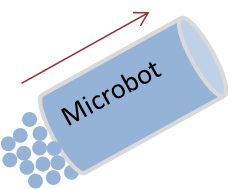This article provides a brief insight in the field of nanomachines and nanosensors, the challenges faced by the researchers in this field, and the promise they hold for us in future applications.
When we talk about about nanomachines, we consider devices which are only a few atoms apart in their dimensions whereas in microsystems, the dimensions are in the range of a few microns. Thus, these devices can only be observed under HR-TEM (High Resolution Tunneling Electron Microscope) or thermal imaging techniques.

The very first challenge that we face as a result of too much scaling down is how we are going to move these tiny machines; be it a nanocar a few atoms across or a nanobot? We simply cannot fit an even smaller diesel engine or a servo motor. Instead, we use some other phenomena, which are insignificant in macro scale but cannot be ignored in microscale.
Several years ago, researchers at RICE University created nanocars which are only a few atoms wide. They were made to move by thermal excitation
Let us consider another example. This time, a microbot. These ‘microbots’ are small tubes that are made of several layers of different metals. They are designed to pick up unhealthy damaged cells and transport them within our body. So how do we move them? Hydrogen Peroxide is used as a fuel for these bots. The highly reactive compound produces bubbles of oxygen which acts as the exhaust of a nano jet engine, thus propelling the bot forward.

Now you must be wondering, “Hold on, this means the bot will keep moving in one direction only, this is not very useful”. They can do so by using magnetic fields to change their direction of motion.

The field of nanodevices are still in its R & D stage and everything is still confined in the laboratory. Nonetheless, these devices hold a lot of promise. Scientists are working on being able to control these nanomotors inside of living material as well, which would enhance the possible applications. As this field continues to grow, we can imagine these nanomachines will be able to help with countless applications – from breaking down kidney stones to fighting cancer, breaking up blood clots, cleaning wounds and removing infections. Recent advancements show a lot of promise in DNA repair and treating diseases which cannot be treated by conventional medical practices. The applications and advantages really are endless!
